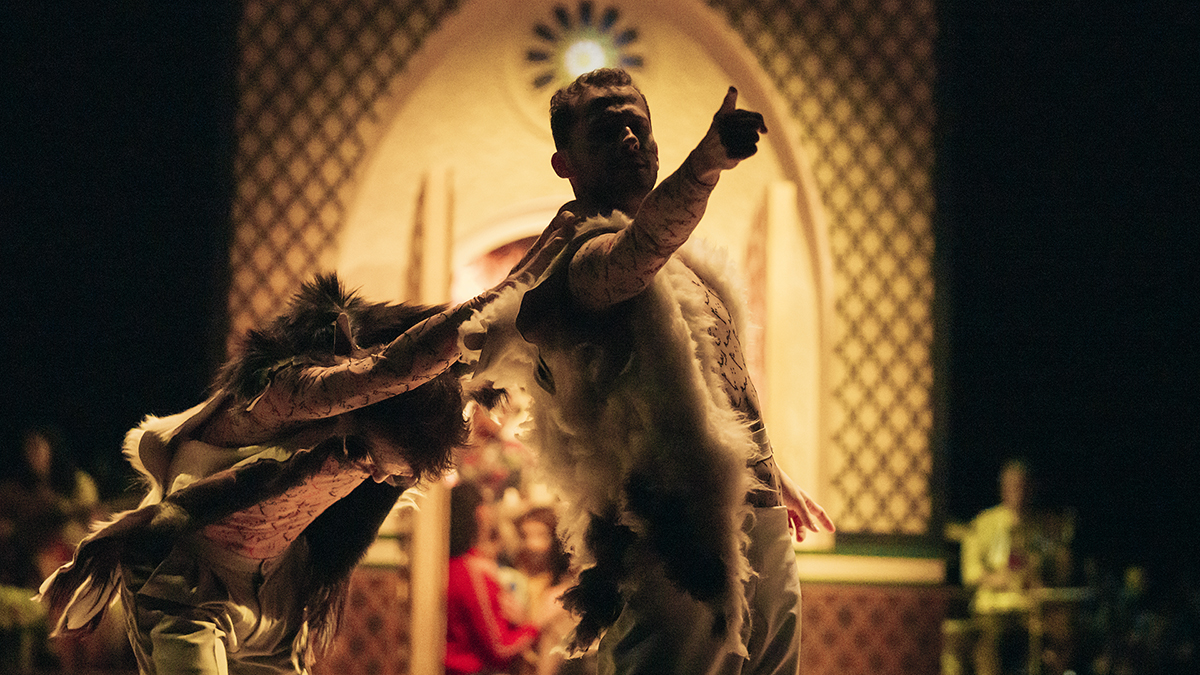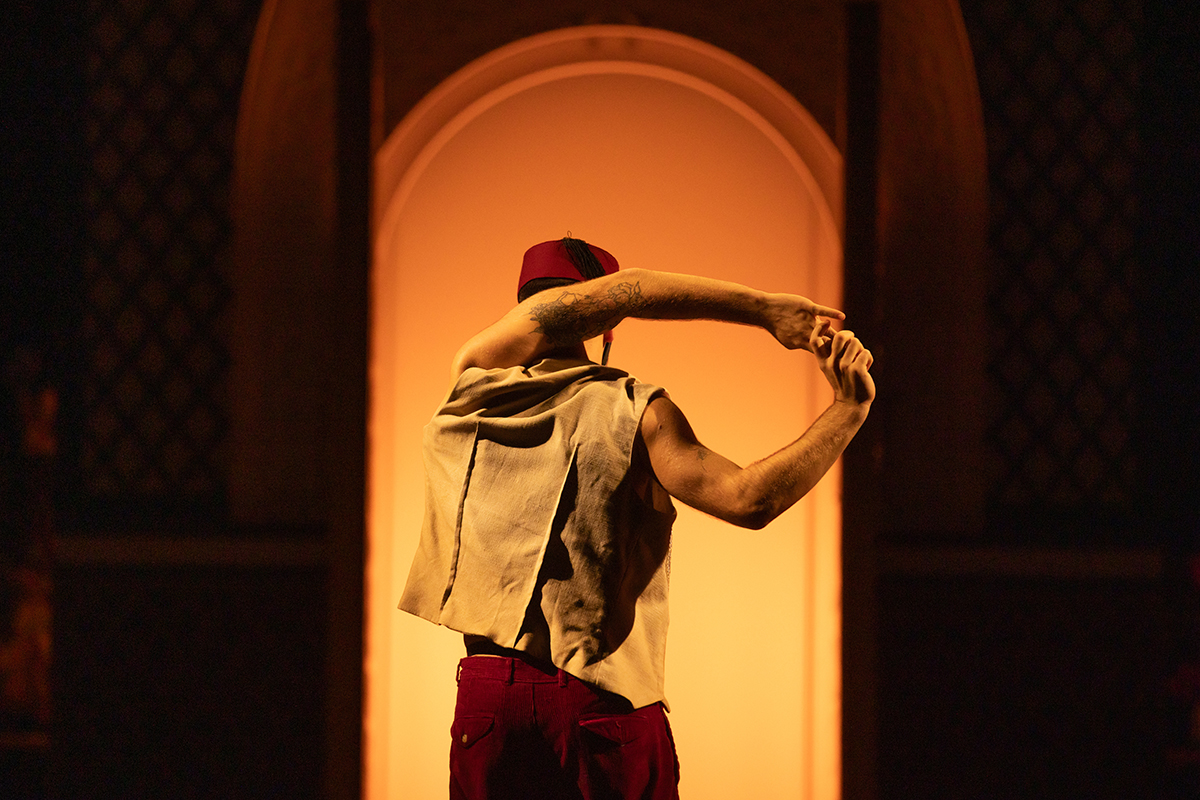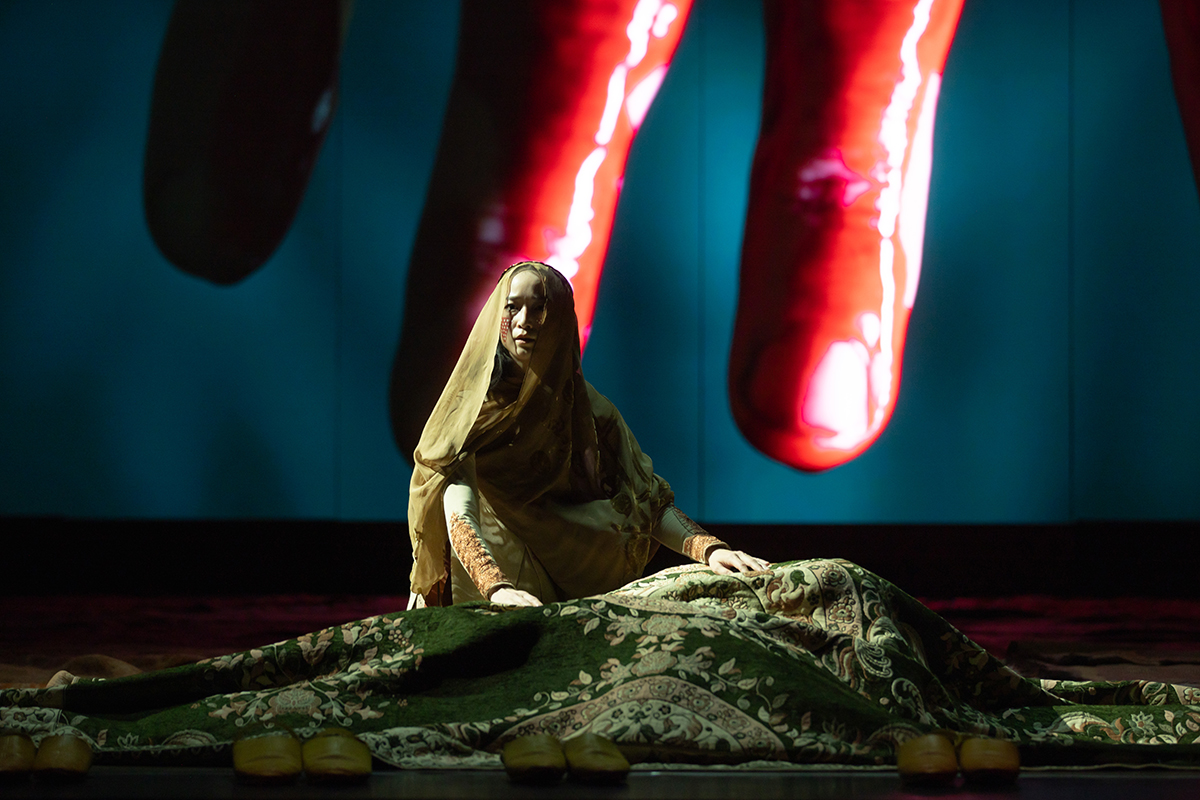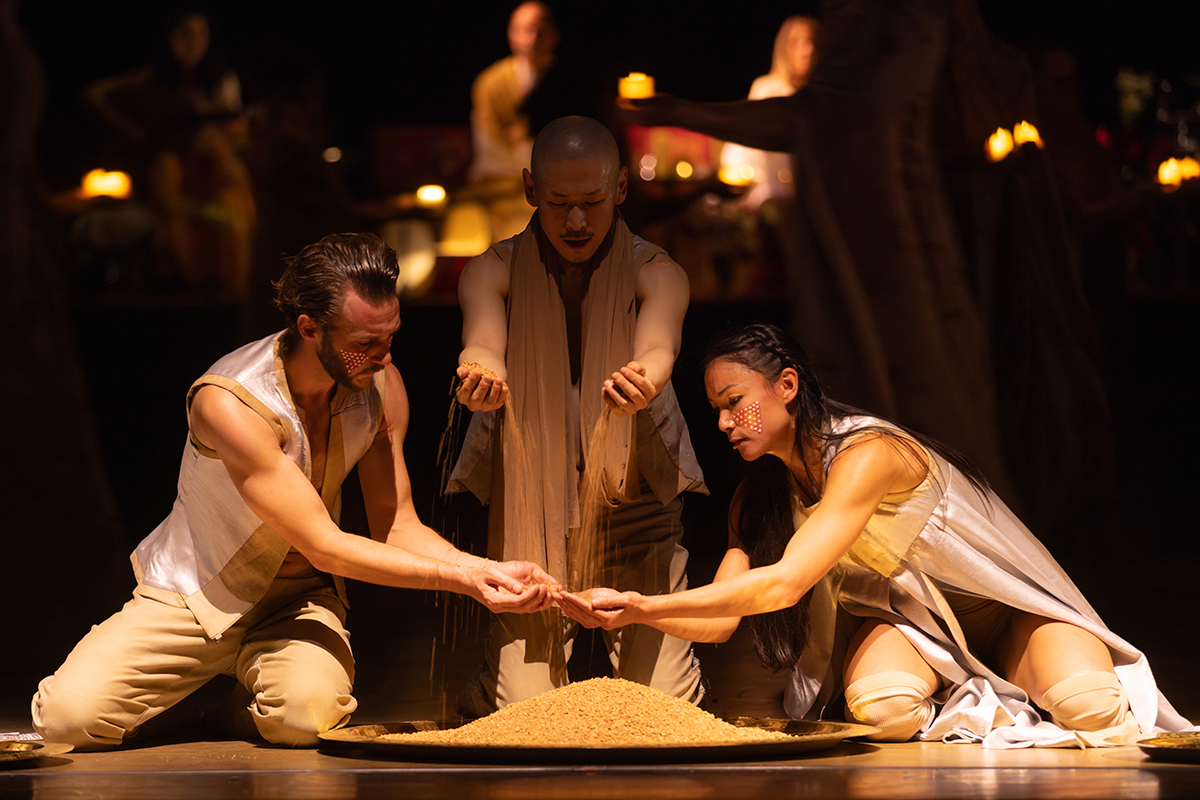Geneva, a city renowned for its elegance and cosmopolitan spirit, is home to the Grand Théâtre de Genève, a venue that epitomizes artistic excellence. With its neoclassical architecture, gilded interiors, and state-of-the-art facilities, the theatre has become one of Europe’s premier cultural institutions. Hosting operas, ballets, and theatrical performances that span genres and geographies, the Grand Théâtre is more than a stage—it is a crucible for storytelling that transcends boundaries. Stepping into its majestic hall is an experience, where anticipation hangs in the air, and a shared love of the arts unites the audience.
Last night, the Grand Théâtre hosted a world premiere that left audiences spellbound: Ihsane, the latest creation by Sidi Larbi Cherkaoui. Widely regarded as one of the most innovative choreographers of our time, Cherkaoui’s works have consistently pushed the boundaries of contemporary dance. With Ihsane, he brings an intensely personal narrative to the stage, weaving a tapestry of themes that resonate deeply with the human condition—loss, identity, and reconciliation.
This ballet, a co-production with prestigious institutions like Eastman, Théâtre du Châtelet, and Tanz Köln, reflects Cherkaoui’s artistry’s global appeal. The choice to premiere such a groundbreaking work in Geneva was as deliberate as it was fitting. The city’s cultural openness and commitment to fostering cross-cultural dialogue align perfectly with the essence of Ihsane.
The title itself carries profound significance. In Arabic, Ihsane represents an ideal of kindness, compassion, and spiritual communion. It’s a term that captures the essence of Cherkaoui’s narrative and the spirit of the performance—a poignant meditation on human connection and resilience. The ballet draws from the choreographer’s journey as he reflects on the loss of his father and the broader complexities of identity. Through movement, music, and visuals, Ihsane transcends its specific inspirations to become a universal tale, inviting audiences to reflect on their relationships with memory, heritage, and belonging.
As the lights dimmed and the first strains of live music filled the air, the audience was drawn into a world where cultures converged and emotions danced harmoniously. For nearly 90 minutes, the stage became a living canvas painted with the hues of Cherkaoui’s imagination. From the fluid grace of the dancers to the haunting melodies performed by world-class musicians, every element of the performance worked in concert to create an experience that was as intellectually stimulating as it was emotionally stirring.
This article explores the many facets of Ihsane—its creator’s remarkable journey, the thematic depth of the ballet, and the sheer artistry that made it an unforgettable experience. Last night’s performance was more than a celebration of dance; it was a testament to the power of art to connect, heal, and illuminate the beauty of our shared humanity.
Sidi Larbi Cherkaoui – The Artist and His Journey
Sidi Larbi Cherkaoui is a name that has come to define a generation of choreographers, celebrated for his ability to bridge cultures, artistic forms, and human experiences. Born in Antwerp in 1976 to a Moroccan father and a Flemish mother, Cherkaoui’s life has been a journey of dualities. His upbringing was marked by his Moroccan heritage and the Western European culture surrounding him, creating a unique perspective that would later shape his artistic vision.
From a young age, Cherkaoui was deeply fascinated with movement and storytelling. His early exposure to diverse dance forms, including voguing, hip-hop, and African dance, gave him a rich vocabulary of movement that he began to refine as a young adult. In his late teens, he entered the prestigious P.A.R.T.S. school in Brussels, founded by Anne Teresa De Keersmaeker, where he immersed himself in contemporary dance techniques and the works of legendary choreographers like William Forsythe and Pina Bausch. These formative years shaped his choreographic style, which blends rigorous technique with emotional resonance.
Cherkaoui’s career took off in the late 1990s when he collaborated with renowned companies like Les Ballets C de la B, creating Rien de Rien (2000) and Foi (2003). These works established his reputation as a boundary-pushing artist who could use dance to explore philosophical and cultural questions. His collaborations with Akram Khan (Zero Degrees) and Damien Jalet (Babel(words)) further expanded his reach, earning him international acclaim and prestigious awards like the Laurence Olivier Award for Best New Dance Production.
What distinguishes Cherkaoui from his contemporaries is his deeply reflective and interdisciplinary approach to choreography. For him, dance is not just movement; it is a language that conveys the complexities of identity, belonging, and human connection. His works often draw on his own experiences as a child of immigrant parents, as well as his identity as a queer Arab artist. These perspectives infuse his choreography with a rare authenticity, making his pieces both intensely personal and universally relatable.
In 2010, Cherkaoui founded Eastman, a dance company based in Antwerp, which became the platform for many of his most celebrated works. With Eastman, he created productions that transcended the traditional confines of contemporary dance, incorporating elements of theatre, visual art, and live music. Pieces like Sutra (2008), which featured Shaolin monks, and Puz/zle (2012), which explored the fragmentation and reconstruction of identity, showcased his ability to synthesize seemingly disparate influences into cohesive and deeply affecting works.
Cherkaoui’s appointment as the artistic director of the Royal Ballet of Flanders in 2015 and later of the Grand Théâtre de Genève in 2022 marked new chapters in his career. These roles allowed him to mentor a new generation of dancers while continuing to develop his artistic voice. His works are as diverse as his influences, ranging from operatic productions to collaborations with pop artists like Beyoncé, for whom he choreographed the iconic Apeshit music video.
In Ihsane, Cherkaoui’s latest creation, all these threads come together in a poignant exploration of identity and memory. The ballet is deeply rooted in his personal history, reflecting on the loss of his father and the enduring impact of his Moroccan heritage. Yet, it also speaks to universal themes, inviting audiences to consider their relationships with their past and their place in a multicultural world. Through Ihsane, Cherkaoui once again proves that he is not just a choreographer but a storyteller, philosopher, and visionary artist whose work resonates across borders and generations.
Ihsane – A Journey of Memory, Culture, and Artistry
At its heart, Ihsane is a masterful convergence of dance, music, and visual art, brought to life by Sidi Larbi Cherkaoui’s vision and the collective brilliance of a multidisciplinary team. The ballet is a profoundly personal exploration of loss, identity, and reconciliation, but it also transcends its specific inspirations to resonate universally. Through its 85-minute runtime, the audience is invited into a world where every movement, note, and image tells a story of interconnectedness.

The title, Ihsane, is derived from the Arabic concept of excellence and compassion, reflecting a spiritual ideal of goodness and selflessness. For Cherkaoui, this word encapsulates the essence of the work: a poetic meditation on the bonds that connect us, to our pasts, and our shared humanity. These themes are central to the narrative and woven into every aspect of the production.
The choreography is a testament to Cherkaoui’s genius. Known for his fluid, almost liquid style, Cherkaoui’s movements evoke the human spirit’s fragility and resilience. The dancers—22 from the Ballet du Grand Théâtre de Genève and four from Eastman—perform with breathtaking precision and emotional depth. Their bodies flow seamlessly across the stage, embodying the tension between tradition and modernity, memory and renewal. Highlights include a duet that symbolizes the father-son relationship, filled with tenderness and longing and an ensemble piece where the dancers form interlocking patterns, symbolizing the threads of shared identity.

The musical score, composed by the Tunisian virtuoso Jasser Haj Youssef, is equally powerful. Played live on stage, the music is an intricate blend of classical Arabic melodies and contemporary elements. Haj Youssef’s mastery of the viola d’amore lends a hauntingly beautiful tone, while the oud, piano, and percussion create a rich tapestry of sound. Vocalists Mohammed el Arabi-Serghini and Fadia Tomb El-Hage deliver spellbinding performances, their voices carrying the weight of centuries of cultural tradition. Whether performing Moroccan spiritual chants or Lebanese-inspired laments, their voices bridge the past and the present, anchoring the ballet in a profoundly emotional and cultural context.
Visually, Ihsane is a feast for the eyes. The scenography by Moroccan artist Amine Amharech transforms the stage into a dreamlike landscape, where elements of the Moroccan desert merge with abstract representations of memory. Projections of shifting sands, starry skies, and intricate geometric patterns evoke a sense of impermanence and timelessness. Amharech’s designs create an immersive environment that draws the audience into Cherkaoui’s inner world.
Costume designer Amine Bendriouich further enhances the visual storytelling with garments inspired by traditional Berber attire. Flowing robes and structured ensembles in hues of saffron, sand, and deep indigo reflect the narrative’s cultural roots while transcending the boundaries of time and place. The costumes become an extension of the dancers’ movements, emphasizing both their individuality and unity.

The lighting, crafted by Fabiana Piccioli, plays a crucial role in shaping the ballet’s atmosphere. Shifting between warm, golden tones and stark, shadowed contrasts, the lighting design mirrors the piece’s emotional journey. At moments of collective harmony, the stage is bathed in light, creating a sense of hope and transcendence. In more reflective moments, the use of shadow and silhouette adds a layer of intimacy and vulnerability.
The production also incorporates video art by Maxime Guislain, whose subtle yet impactful projections add another dimension to the performance. Whether it’s images of an overflowing Moroccan cemetery or abstract patterns that mimic the dancers’ movements, the video art deepens the audience’s connection to the ballet’s themes.
Every element of Ihsane serves a purpose, and together, they create a cohesive and profoundly affecting whole. It is not merely a ballet but a living, breathing work of art that bridges cultures, generations, and emotions. As the final notes of the score linger in the air and the dancers form a circle of light on the stage, the audience is left with a profound sense of connection—both to the performers and their humanity. This is the power of Ihsane: it speaks to us all, inviting us to reflect on who we are, where we come from, and how we move forward.
Why Ihsane is an Extraordinary Ballet
What makes Ihsane such a remarkable piece of art is its ability to weave profound human emotions into a breathtakingly modern yet timeless narrative. At its core, Ihsane is a meditation on grief—deuil—and how it shapes our lives, often in ways we fail to understand fully. In a society that increasingly avoids the pain of loss, Ihsane dares to confront it head-on, not as an end but as a transformation. Sidi Larbi Cherkaoui offers the audience a space to reflect on this often-overlooked human experience, guiding us toward acceptance and reconciliation.

Cherkaoui uses dance to explore grief as both a personal and collective experience. His choreography captures the heaviness of sorrow and the fluidity of healing, showing how these states coexist within us. One particularly poignant moment involves a solo dancer navigating a chaotic ensemble, symbolizing the isolation often felt in mourning. Yet, through connection—embodied by duets and group formations—the dancer is eventually re-integrated, reflecting the resilience of the human spirit.
Beyond grief, Ihsane delves into the relationships between past and future, father and son, and disparate cultures. Cherkaoui’s personal story—his search for the father he lost as a teenager and the fatherland that shaped his identity—serves as the emotional bedrock of the ballet. These profoundly personal themes resonate universally, as we all grapple with heritage, identity, and belonging questions. The ballet becomes a mirror, reflecting the audience’s struggles and triumphs in navigating the intersections of past and present.
Ihsane also challenges contemporary notions of identity, offering a vision of coexistence rooted in diversity. Cherkaoui, as a queer Arab artist, embodies this diversity, and his work celebrates the beauty of blending identities rather than isolating them. The ballet’s music, costumes, and staging are steeped in Moroccan and Arabic influences, offering a luminous portrayal of the Arab world and Islam—one that counters stereotypes and highlights the richness of these cultures.
The spiritual underpinnings of Ihsane are also significant. The Arabic term ihsane refers to an ideal of kindness and moral excellence, often tied to a deep spiritual connection. Cherkaoui infuses this concept into every element of the ballet, from the compassionate movements of the dancers to the harmonious interplay of music and visuals. This spiritual dimension elevates the ballet, transforming it into a meditation on living with intention, kindness, and connection.
The emotional resonance of Ihsane is amplified by its optimistic outlook. While it delves into loss and identity, it ultimately leaves the audience with a sense of hope. Cherkaoui offers a vision of a world where differences do not divide but enrich us, where the past is not a weight but a foundation, and where humanity’s shared experiences connect us in ways that transcend borders.
Finally, Ihsane is extraordinary for its ability to bridge the personal and the universal. Cherkaoui’s exploration of his father-son relationship becomes a vehicle for understanding broader questions of heritage and identity. Similarly, portraying Moroccan and Arab cultures becomes a universal celebration of diversity and humanity. The ballet’s closing moments—a luminous circle formed by the dancers—symbolize this unity, leaving the audience with a profound sense of connection and possibility.
In a world often marked by division and disconnection, Ihsane reminds us of our shared humanity. It challenges us to confront our grief, celebrate our identities, and seek harmony in a world that too often forgets the beauty of coexistence. Through its artful storytelling and emotional depth, Ihsane not only captivates but transforms, making it an extraordinary work that will linger in the hearts and minds of its audience long after the final bow.
Final words: A Triumph of Art and Humanity
With Ihsane, Sidi Larbi Cherkaoui has created a ballet that transcends the boundaries of dance, becoming a profound exploration of identity, grief, and unity. It is a work that connects the profoundly personal with the universal, offering audiences a space to reflect on their journeys while celebrating the rich tapestry of cultures and experiences that shape our world. Cherkaoui’s ability to blend the deeply emotional with the visually stunning and intellectually stimulating solidifies his place as one of the most influential choreographers of our time.
Although the final performance in Geneva has concluded, Ihsane will continue to touch hearts as it tours Europe, with upcoming performances in Cologne, Paris, Luxembourg, and beyond. Each audience will encounter a work that not only entertains but transforms—encouraging reflection on themes that are as timeless as they are urgent.
As I left the Grand Théâtre de Genève last night, I felt overwhelming hope. Ihsane is a tribute to the resilience of the human spirit and a luminous vision of what art can achieve. It reminds us of the threads that connect us across cultures, generations, and histories, weaving a story of shared humanity that is as vital as ever.
Cherkaoui’s Ihsane is such a journey that invites us to look within and beyond, finding beauty and connection in every step.
José Amorim
The author sourced the information for luxuryactivist.com. All content is copyrighted, and reproduction rights are not available. Images are for illustration purposes only.
Photo credits:
Photo d’illustration © GTG / Diana Markosian
Ihsane © GTG / Gregory Batardon
Ihsane © GTG / Filip Van Roe
This story originally appeared on Luxuryactivist

